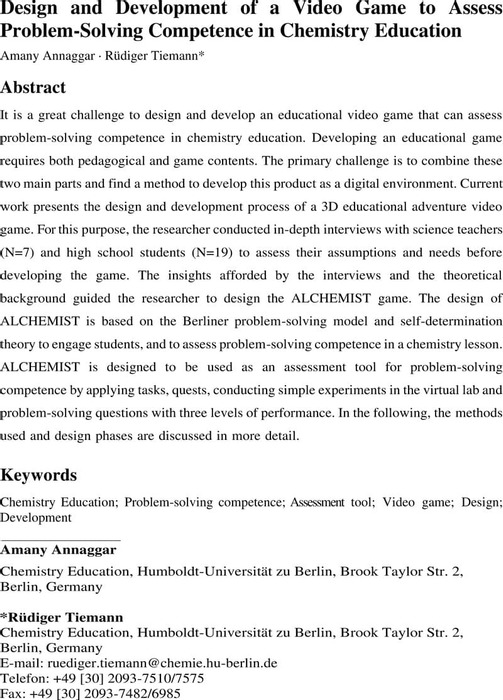Abstract
The aim of this study is to present how to implement the constructive learning theory and self-determination theory into a video game. This video game is designed as a new kind of teaching tool for chemistry concepts and as an assessment tool for domain-specific problem-solving competence, by applying a problem-solving model and the factors of self-determination theory through game elements. These types of video games are designed not only to have fun and motivate students, but also to help the teachers and educators to assess their students according to their weaknesses and strengths in each particular phase of the competence. Thus, educators could improve their teaching strategy or use the tools to improve weak areas. Based on this idea, we developed ALCHEMIST. ALCHEMIST targeted the 9th-grade students in the German chemistry curriculum. The scientific content is about acids, bases, and indicators, and is designed and based on the problem-solving model to access this competence of the students. The 3D game framework was chosen for this game since it makes the game efficient, interactive and drives it into more virtual reality. The designing process was complicated, as it includes multidisciplinary work across psychology, design, scientific content, development and programming, which makes it challenging. To cover these points, we followed a game design model, adding some steps to cover the educational needs and the aim of the game.
In order to make the game more effective and interactive, and to drive it into a more virtual world, the 3D game framework was chosen for this game since for this age group a 3D educational game is expected to be more effective (Gunter et al, 2008; Terzidou et al, 2012) . Moreover, the use of avatars in the 3D virtual environment establishes non-verbal communication (NVC) features, which can foster collaboration interactions, and enhance the student’s ability to apply abstract knowledge later in reality (Dede, 1992; Tsiatsos and Terzidou, 2010). The log file provided shows the player points and gameplay path which indicates the performance levels for each problem set. Also, it can help teachers to evaluate each particular phase of problem-solving competence. After the success of the development of our game-based theoretical background, it will be tested and validated by experts in chemistry education. This validation process should examine if the problem-solving model is correctly applied and test the significance of the game design, scientific content and the game’s objective.
It may also be of interest to develop such video games with scientific content and educational background in other fields. It also would be a success for the scientist to apply the scientific content through a fantasy 3D video game to the students at different ages to have fun, to learn, and to assess their competencies.
Content



![Author ORCID: We display the ORCID iD icon alongside authors names on our website to acknowledge that the ORCiD has been authenticated when entered by the user. To view the users ORCiD record click the icon. [opens in a new tab]](https://chemrxiv.org/engage/assets/public/chemrxiv/images/logos/orcid.png)



